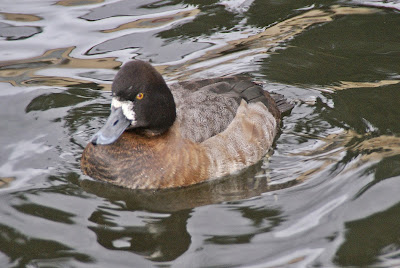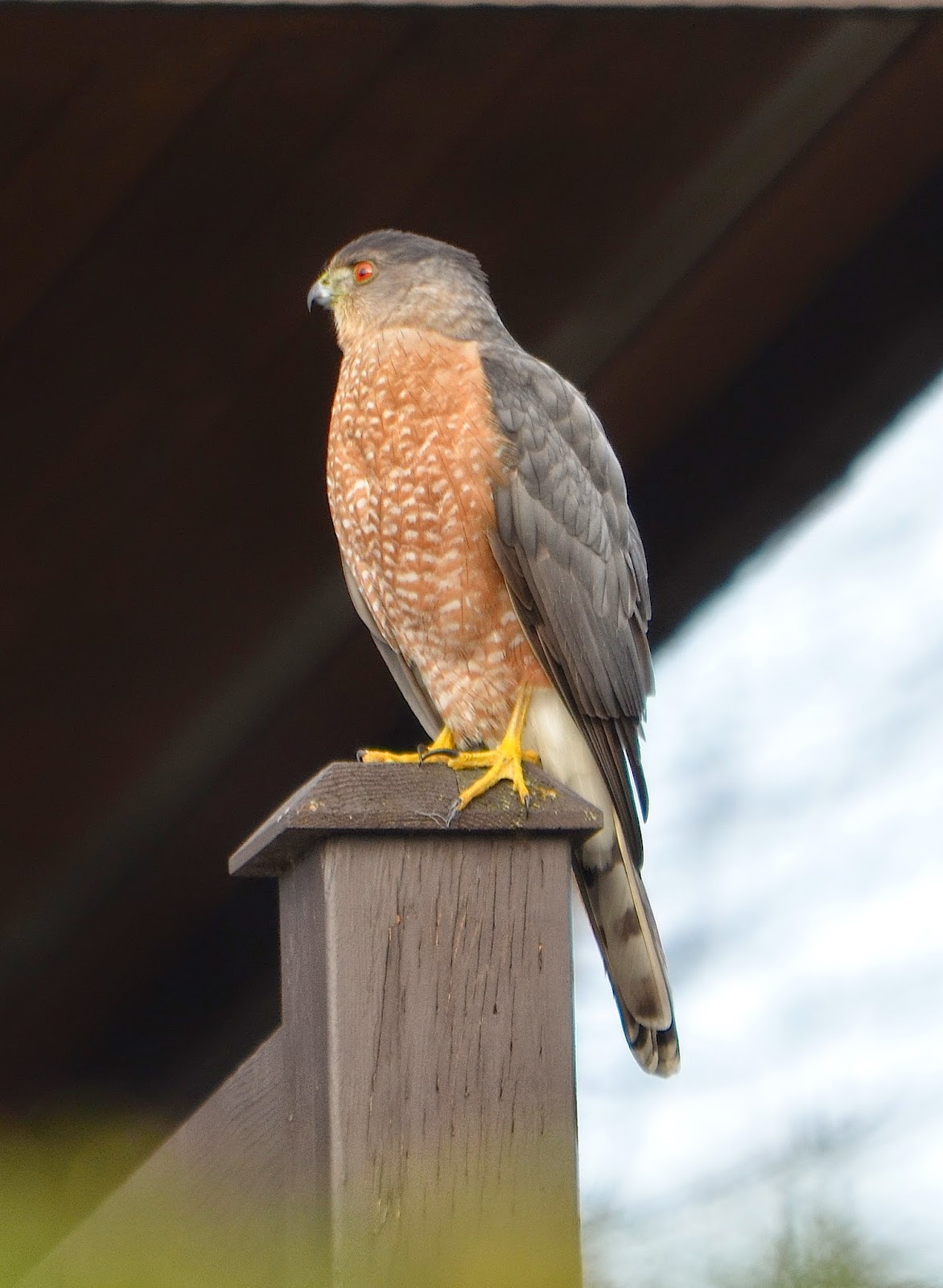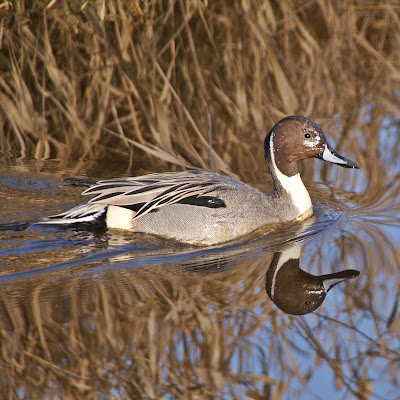In addition to lighthouses, I have taken many photos of birds at home and on my travels. Thought I would share them as I have my lighthouse pictures. Hope you enjoy. Cheers, Neal
Saturday, November 23, 2013
Turkey Vulture
The Turkey Vulture (Scientific name - Cathartes aura) is found throughout the U.S.A., as far South as Mexico and into Southern Canada. These birds have a good sense of smell which they follow to locate carcasses of dead animals. They have long wings and can be seen soaring over areas of potential food. They have brownish back and wings, black underparts, a long tail and a small red head with naked skin around the eye. Top photo taken in March 2014 in Abbotsford, B.C. Bottom photo taken in 2011 near Miami, Florida.
Friday, November 15, 2013
Cooper's Hawk
The Cooper's Hawk (Scientific name - Accipiter cooperii) is a medium sized woodland hawk that is capable of maneuvering quickly through fairly dense vegetation. It feeds mainly on small birds and is sometimes found near bird feeders. It also feeds on small animals such as chipmunks and small squirrels.
The Cooper's Hawk is found in the Southern parts of Canada and as far South as Mexico.
The Cooper's Hawk has greyish blue upper parts and a darker crown and red eyes. The tail is rounded and has bands of white at the tip. While they look similar to the Sharp Shinned Hawk, the Sharp Shinned Hawk is smaller and the tip of the tail is not rounded.
Top two photos were taken in November 2013 in Abbotsford, B.C. Bottom photo taken in Abbotsford, B.C. in December 2014.
The Cooper's Hawk is found in the Southern parts of Canada and as far South as Mexico.
The Cooper's Hawk has greyish blue upper parts and a darker crown and red eyes. The tail is rounded and has bands of white at the tip. While they look similar to the Sharp Shinned Hawk, the Sharp Shinned Hawk is smaller and the tip of the tail is not rounded.
Top two photos were taken in November 2013 in Abbotsford, B.C. Bottom photo taken in Abbotsford, B.C. in December 2014.
Wednesday, November 6, 2013
Lesser Scaup
The Lesser Scaup (Scientific name - Aythya affinis) is the most common diving duck that is found in North America. They breed from Alaska across to Eastern Canada and winter as far South as the Caribbean and Northern South America. The majority winter on the coastlines, but some winter on reservoirs and lake further inland.
The males have a purple-green gloss to their heads and pale flanks. The females are duller in colour and have a white patch around the base of their bill. They are very similar to the Greater Scaup.
Photos all taken at Mill Lake in Abbotsford, B.C. in 2011 and 2013.
 |
| Male |
 |
| Female |
Photos all taken at Mill Lake in Abbotsford, B.C. in 2011 and 2013.
 |
| Male |
 |
| Female |
Tuesday, October 29, 2013
House Finch
The House Finch (Scientific name - Carpodacus mexicanus) is a bird found throughout most of North America. It was first reported in 1941 in the Eastern U.S. and is believed to have originated from the illegal bird trade.
Males display red on their head and chest and have a streaked underbelly. Females do not have the red and are mostly brown streaked.
Top three photos taken in Abbotsford, B.C. in October 2013 and the bottom photo taken in August 2012 at the George C. Reifel Migratory Bird Refuge in Delta, B.C.
Males display red on their head and chest and have a streaked underbelly. Females do not have the red and are mostly brown streaked.
Top three photos taken in Abbotsford, B.C. in October 2013 and the bottom photo taken in August 2012 at the George C. Reifel Migratory Bird Refuge in Delta, B.C.
 |
| Female and Male at Feeder |
Friday, October 18, 2013
Clark's Nutcracker
The Clark's Nutcracker (Scientific name - Nucifraga columbiana) is a bird in the crow family and found in the mountains of Western Canada and the U.S. They are often found in pine forests as they feed on seeds from pine cones. They are also often found in scenic areas begging food from tourists.
They are pale grey birds with black wings. The tail is black in the center and white along either side. They have a long straight and sharp tipped bill.
Photos were taken at Manning Park, British Columbia in May 2013.
They are pale grey birds with black wings. The tail is black in the center and white along either side. They have a long straight and sharp tipped bill.
Photos were taken at Manning Park, British Columbia in May 2013.
House Sparrow
The House Sparrow (Scientific name - Passer domesticus) was first introduced to North America in Brooklyn, New York in 1850 and today is found in most of North America. It is also found in Central America, South America and the West Indies. They are native to Europe and Asia but have been introduced to many parts of the world. It differs from the other 'sparrows' in that it comes from the Eurasian weaver-finch family. They have a fuller chest and more rounded head and shorter tail than most other 'sparrows'. They are a common bird and are found often in developed and urban areas.
They have a grey head, white cheeks and a black throat. The black throat patch is much more predominate in breeding males (as in the third photo). Back and wings are striped with buff, black and brown.
Top photo taken in Whistler, B.C. in October 2013. The other photos were taken on the island of Maui in Hawaii in November 2012.
They have a grey head, white cheeks and a black throat. The black throat patch is much more predominate in breeding males (as in the third photo). Back and wings are striped with buff, black and brown.
Top photo taken in Whistler, B.C. in October 2013. The other photos were taken on the island of Maui in Hawaii in November 2012.
 |
| Female |
Monday, October 14, 2013
Song Sparrow
The Song Sparrow (Scientific name - Melospiza melodia) is a common sparrow found throughout much of North America from as far North as Southern Alaska and South to Mexico. They are often seen on the ground and in low vegetation.
The Song Sparrow is a medium sized sparrow and is mostly brown and grey. It has bold streaking on its white chest and a reddish brown cap and a brown streak through its eye.
Top two photos taken in Abbotsford, B.C. in October 2013 and the bottom photo was taken at the George C. Reifel Migratory Bird Sanctuary in March 2013. The photo second from the bottom was taken at Piper Spit, Burnaby Lake, Burnaby, B.C. in May 2015.

The Song Sparrow is a medium sized sparrow and is mostly brown and grey. It has bold streaking on its white chest and a reddish brown cap and a brown streak through its eye.
Top two photos taken in Abbotsford, B.C. in October 2013 and the bottom photo was taken at the George C. Reifel Migratory Bird Sanctuary in March 2013. The photo second from the bottom was taken at Piper Spit, Burnaby Lake, Burnaby, B.C. in May 2015.

Tuesday, October 8, 2013
Anhinga
The Anhinga (Scientific name - Anhinga anhinga) is a waterbird found in the Southern U.S. around the Gulf of Mexico. It is also found in the Caribbean and into South America as far South as Uruguay. These birds like warm water and prefer fresh water. They are known by a number of names including, Water Turkey, Snakebird (because they swim with just their long necks out of the water), and the American Darter.
The Anhinga has a long 'S' shaped neck and long thin pointed bill. They have long broad tail feathers.
Last photo taken in February 2011 and others in August 2016 at Lake Tohopekaliga, Florida
The Anhinga has a long 'S' shaped neck and long thin pointed bill. They have long broad tail feathers.
Last photo taken in February 2011 and others in August 2016 at Lake Tohopekaliga, Florida
Monday, October 7, 2013
Dark Eyed Junco
The Dark Eyed Junco (Junco hyemalis) is a common small sparrow found throughout North America. They breed mostly in Canada and winter in the U.S. and as far south as Northern Mexico. In some areas of South West Canada and the Western U.S. they are year round inhabitants. The Dark Eyed Junco is observed mostly on the ground at the base of trees and in bushes, or under bird feeders.
Dark Eyed Juncos are mainly grey and brown with a white underbelly. Some have noticeably darker heads and those are sometimes known as Oregon Juncos.
Photos taken in Abbotsford, B.C. in October 2013.

Dark Eyed Juncos are mainly grey and brown with a white underbelly. Some have noticeably darker heads and those are sometimes known as Oregon Juncos.
Photos taken in Abbotsford, B.C. in October 2013.

Wednesday, October 2, 2013
Snow Goose
The Snow Goose (Scientific name - Chen caerulescens) is a species of goose found in North America. They breed in the North of Canada and Alaska and also in Greenland and Northeast Siberia. They migrate South as far as Mexico. They are often observed in large flocks and like wetlands and agricultural fields. There is a darker morph of this species that is known as the Blue Goose.
The Snow Goose is mainly white with black wing tips.
Top photo taken in March 2010 in the Fir Island area of Skagit County, Washington, U.S.A. Remainder taken in October 2014 on Westham Island, Delta, B.C.
The Snow Goose is mainly white with black wing tips.
Top photo taken in March 2010 in the Fir Island area of Skagit County, Washington, U.S.A. Remainder taken in October 2014 on Westham Island, Delta, B.C.
 |
| Juvenile |
Saturday, September 21, 2013
Blue Tit
The Blue Tit (Scientific name - Cyanistes caeruleus) also known as the European Blue Tit is a common bird throughout much of Europe. The range extends from Ireland and the U.K. to Southern and Central Scandinavia and East to Western Russia, Turkey and Northern Iran and Iraq. These birds tend to not migrate, however to move to areas of lower elevation in severe winters.
The Blue Tit has a short stubby dark bill, white cheeks on its face with a thin dark blue or black line through the eyes to the nape. The crown is blue and the back is olive yellow/green and wings are blue. Underparts are yellow and the top of the tail is blue.
Photos taken in Kensington Gardens, London, England in April 2013.
The Blue Tit has a short stubby dark bill, white cheeks on its face with a thin dark blue or black line through the eyes to the nape. The crown is blue and the back is olive yellow/green and wings are blue. Underparts are yellow and the top of the tail is blue.
Photos taken in Kensington Gardens, London, England in April 2013.
Ostrich
The Ostrich (Scientific name - Struthio camelus) also known as the Common Ostrich is a large flightless bird native to Africa. These birds, which are now farmed in many parts of the world can reach a height of eight feet and weigh as much as 300 pounds, although the average is 230 pounds.
These birds have long necks and legs. The adult male has mostly black feathers with white tail and front. Young and females are mostly greyish brown in colour.
Top photo taken near Cape of Good Hope, South Africa in September 2010. Bottom photos taken at an Ostrich Ranch in Aruba in November 2010.
These birds have long necks and legs. The adult male has mostly black feathers with white tail and front. Young and females are mostly greyish brown in colour.
Top photo taken near Cape of Good Hope, South Africa in September 2010. Bottom photos taken at an Ostrich Ranch in Aruba in November 2010.
Wednesday, September 18, 2013
Northern Pintail
The Northern Pintail (Scientific name - Anas acuta), also just known as Pintail is a dabbling duck found in many parts of North America and Eurasia. In North America it nests as far North as Northern Canada and Alaska. It migrates South as far as Central America and into the North of South America.
The Northern Pintail male has a distinctive chocolate brown head and a long white neck and white underparts. The white extends up in a thin line to the vack of the head. Back is grey/brown with black on the wings. Bill is black with bluish sides. It has distinctive long black center tail feathers giving it its name. The female (in top photo) is basically brown and buff and does not have the distinctive tail feathers.
Photos were taken at the George C. Reifel Migratory Bird Sanctuary in January 2011 and April 2012.
The Northern Pintail male has a distinctive chocolate brown head and a long white neck and white underparts. The white extends up in a thin line to the vack of the head. Back is grey/brown with black on the wings. Bill is black with bluish sides. It has distinctive long black center tail feathers giving it its name. The female (in top photo) is basically brown and buff and does not have the distinctive tail feathers.
Photos were taken at the George C. Reifel Migratory Bird Sanctuary in January 2011 and April 2012.
Monday, September 16, 2013
Western Jackdaw
The Western Jackdaw (Scientific name - Corvus monedula), also known as the European Jackdaw or simply Jackdaw is a bird common to Europe, Western Asia and as far south as Northern Africa. It is a passerine bird in the Crow family. They are found usually in areas of farmland or open woodlands but also in urban areas.
The Jackdaw is a mainly black and grey bird with the grey predominate on its nape. The black is a shiny black.
Photos were taken in April 2013 at Zaanse Schans in the municipality of Zaanstad, North Holland, Netherlands.
The Jackdaw is a mainly black and grey bird with the grey predominate on its nape. The black is a shiny black.
Photos were taken in April 2013 at Zaanse Schans in the municipality of Zaanstad, North Holland, Netherlands.
Saturday, September 14, 2013
Ring Necked Pheasant
The Ring Necked Pheasant (Scientific name - Phasianus colchicum) also known as the Common Pheasant is a large game bird that is native to Asia. It is found in Asia from the Black and Caspian Seas east to China and Korea. It has been introduced to many other parts of the world and was introduced to North America in the 1880's. It is now found throughout most of North America as far North as central British Columbia and Alberta and South into Northern Mexico. While these birds can fly, they often run on the ground when startled.
The male is a very colourful bird with a red and bare face, iridescent green head, white ring around the neck and a maroon breast. Back is brown with black and white spots and the tail is long and barred. The female is plain in colour, mainly mottled brown with black spots and a long barred tail.
Top photo taken in Edison, Washington in May 2011, bottom photos taken in Langley, Washington in September 2013.
 |
| Male |
The male is a very colourful bird with a red and bare face, iridescent green head, white ring around the neck and a maroon breast. Back is brown with black and white spots and the tail is long and barred. The female is plain in colour, mainly mottled brown with black spots and a long barred tail.
Top photo taken in Edison, Washington in May 2011, bottom photos taken in Langley, Washington in September 2013.
 |
| Female |
Monday, September 9, 2013
Pine Siskin
The Pine Siskin (Scientific name - Spinus pinus) is a small songbird in the finch family. It is often found around backyard feeders. As its name suggests it breeds in mixed coniferous forest areas. It breeds in most of Canada, Alaska and the Northern part of Continental U.S. Some migrate as far south as Mexico. This species is unusual in that their migration is variable, perhaps due to food availability, and they migrate in large numbers some years and not in others. The Pine Siskin is a small bird, with heavy streaking on its underbelly and head. They have white and yellow patches on their wings. They have a short notched tail and a sharp pointed bill. Some (like those in the photos) have green colouration similar to that of the European Siskin. Top two photos taken in Abbotsford, B.C. in November 2015 and the bottom photos taken in Whistler, B.C. in September 2013.


Subscribe to:
Comments (Atom)








































